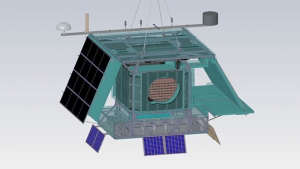
The General AntiParticle Spectrometer (GAPS) experiment, which will fly a payload consisting of a balloon as large as a football stadium in the skies over Antarctica, may hold the answer to one of the biggest questions in modern physics—the nature of dark matter in our Galaxy. The experiment by the University of Hawaiʻi at Mānoa and others will search for very rare cosmic antimatter. The researchers just received a major multi-million dollar funding boost from NASA, with approximately $900,000 going to the UH Mānoa team.

Department of Physics and Astronomy Associate Professor Philip von Doetinchem said UH Mānoa is in charge of qualifying parts of the balloon experiment’s detectors and will lead the data analysis. The GAPS team comprises researchers from UH Mānoa, Columbia University, UCLA, Massachusetts Institute of Technology (MIT), UC Berkeley and Northeastern University, as well as international partners from Japan and Italy. The UH team already received about $500,000 from 2017–21, and NASA’s renewed commitment will ensure the team is able to fly the massive balloon approximately 24 miles above Antarctica in late 2022.
Cosmic rays
Cosmic radiation reaching Earth is composed of different types of particles. The most common ones are protons and the nuclei of helium atoms. Antiparticles, however, are much less common. Antiparticles are in every aspect the same as their corresponding particle counterpart, but have the opposite charge. For instance, a proton has a positive charge, and its antiproton has a negative charge of the same value.
“The search for antiparticles promises to provide a messenger to understand rare processes in our Galaxy that we cannot see with the particle counterpart,” Doetinchem said. “The GAPS project’s key goal is to use antiprotons and antideuterons (the corresponding antinucleus to the nucleus of heavy water, which is called deuterium) to search for dark matter. So far, we have lots of gravitational evidence for the existence of dark matter, but we do not know dark matter’s nature. This is one of the biggest questions in modern physics.”
UH’s key role
The UH Mānoa team is responsible for calibrating the balloon’s sensor detectors, will contribute to the payload and integration efforts during flight operations, and will lead the data analysis after the mission in Antarctica. The calibration procedure was developed with collaborators at MIT, and dedicated state-of-the-art facilities have been set up at UH Mānoa. This calibration work is being carried out by postdoctoral researcher Achim Stoessl, graduate student Cory Gerrity and undergraduate student Hershel Weiner, through funding by UH Mānoa’s Undergraduate Research Opportunities Program (UROP).
Doetinchem said the calibration work will conclude by the end of 2021, and the integration and test phase of the balloon instrument will begin at MIT, UC Berkeley and NASA facilities. After the experiment is completed, Doetinchem’s team will analyze the data. For this purpose, dedicated computing facilities will be purchased with the new NASA funding and operated at UH Mānoa.
Undergraduate student Layne Fujioka, under the guidance of Doetinchem and with funding from UROP, developed an augmented reality app that illustrates how the GAPS experiment works. The app is available on Android and development for the iPhone will begin in fall 2021.
The GAPS project will utilize the same NASA balloon facilities as Professor Peter Gorham’s Antarctic Impulsive Transient Antenna project, which discovered new evidence that suggests some Antarctic particles do not fit the standard model of physics.
This work is an example of UH Mānoa’s goal of Excellence in Research: Advancing the Research and Creative Work Enterprise (PDF), one of four goals identified in the 2015–25 Strategic Plan (PDF), updated in December 2020.
—By Marc Arakaki

